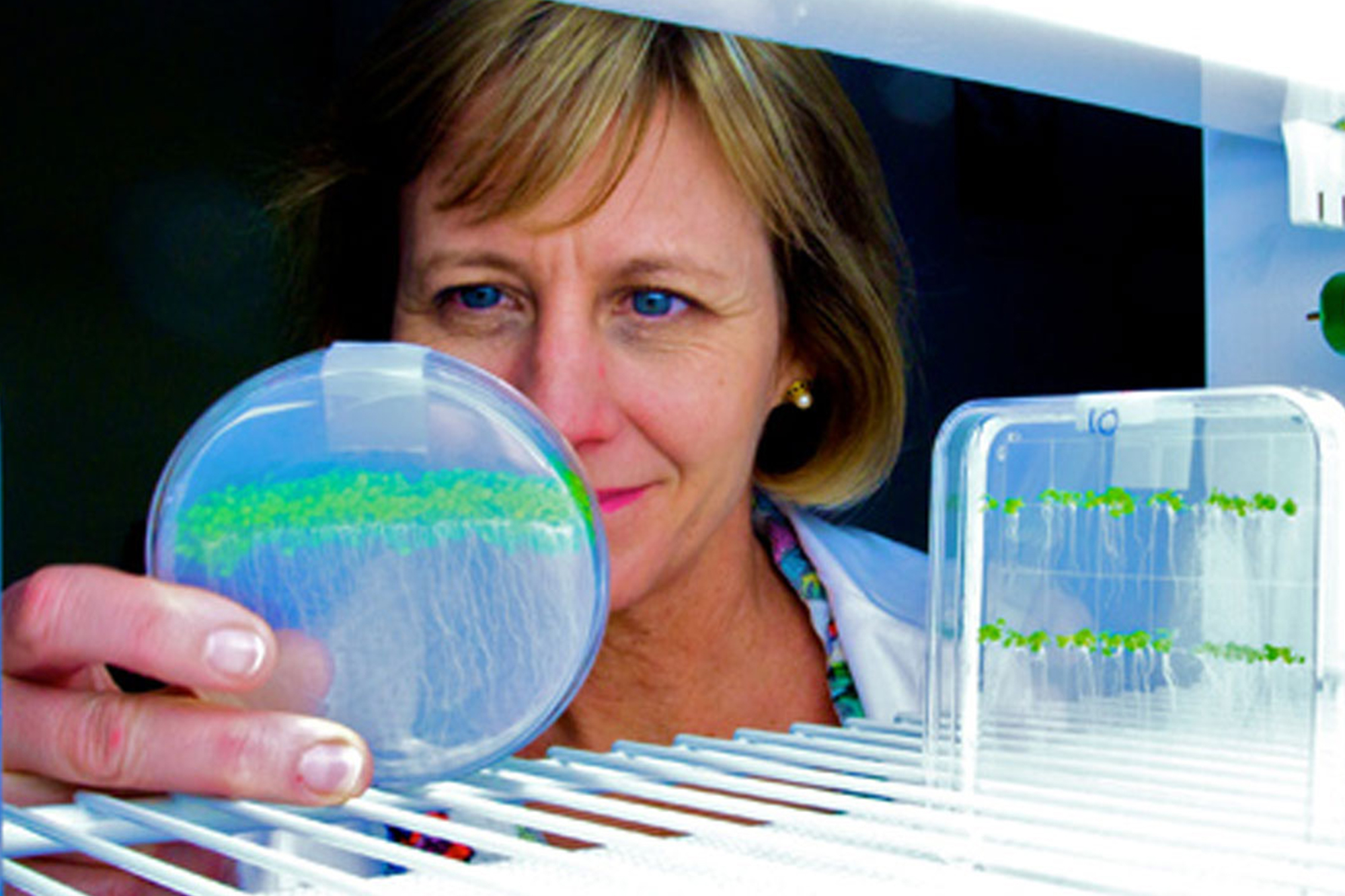
SBS Distinguished Alumna 2020
Julia Bailey-Serres, BS’81, is known for her research on mechanisms of plant adaptive responses to environmental stresses. She remembers enrolling in “a lot of lab classes in genetics, animal physiology and chemistry” at the U. And she fondly recalls a team-taught lab with now Nobel laureate Mario Capecchi. Other teachers and mentors she is quick to mention are Ray Gesteland, Joe Dickinson and E. Tucker Gurney, all emeritus faculty now.
A California native, Bailey-Serres transferred as a sophomore to the U where she immediately got a job in a lab with the late George Edmunds, an aquatic entomologist. “It was an early opportunity to understand what research was,” she says. “It gave me a home and then paid for a summer school class in electron microscopy on insects.”
After graduation, she attended he University of Edinburgh where she earned her PhD studying rearrangements of mitochondrial DNA in sorghum, a genus of flowering plants in the grass family Poaceae. Now Director at the Center for Plant Cell Biology and Distinguished Professor of Genetics at the University of California, Riverside, she was elected to the National Academy of Sciences in 2016 and, in 2020, recognized as a Distinguished Alumna of the School of Biological Sciences.
In addition to Edmunds, while at the U Bailey-Serres was mentored by SBS’s David Wolstenholme who would “steal” her away from his colleague. Cell and molecular biology outside of bacteria and viruses were just beginning to emerge, and Wolstenholme, who would become Department Chair, “didn’t guide me as much as just provided opportunities. [It was a] tremendous undergraduate opportunity,” she says, doing electron microscopy as well as some molecular biology. The research experience was accented by her work during her junior year as a teaching assistant for the non-majors biology class. “I was self-supporting as a student and needed the money for tuition.” Getting paid for lab work, she wryly attests, was “a lot more interesting than washing dishes.”
Even so, she remembers, “I was just this naïve young person interested in science and David gave me the push I needed.” She remembers Wolstenholme’s explaining that she really needed to go to graduate school. As a consequence of her research experience at the U, Bailey-Serres has always had an undergraduate researcher in her own lab, over 100 to date. Fittingly, her first faculty award at Riverside was for her work with budding undergraduate researchers. The kind of relationship she formed with Wolstenholme was arguably prologue to what would become what is now the recently launched Science Research Initiative for undergraduates in the U’s College of Science.
Grains in the Rain
 The Bailey-Serres group develops basic plant research discoveries into technologies or approaches that improve agriculture. By pursuing translational plant biology, says Bailey-Serres, “we aim to harness genetic mechanisms that provide climate change resilience to crops, particularly flooding, drought and nutrient stress resilience.” Her lab works from the single cell to the whole plant level. Their studies have defined mechanisms of low oxygen sensing and post-transcriptional gene regulation, from the epigenome to the “mRNPome” and translatome. “This knowledge is of importance to efforts that seek to stabilize crop yields,” she explains. “As Earth’s population grows, arable land decreases, and climatic patterns change.”
The Bailey-Serres group develops basic plant research discoveries into technologies or approaches that improve agriculture. By pursuing translational plant biology, says Bailey-Serres, “we aim to harness genetic mechanisms that provide climate change resilience to crops, particularly flooding, drought and nutrient stress resilience.” Her lab works from the single cell to the whole plant level. Their studies have defined mechanisms of low oxygen sensing and post-transcriptional gene regulation, from the epigenome to the “mRNPome” and translatome. “This knowledge is of importance to efforts that seek to stabilize crop yields,” she explains. “As Earth’s population grows, arable land decreases, and climatic patterns change.”
In a 2019 paper published in Science she disclosed how other crops compare to rice when submerged in water. Her research found that the plants – a wild-growing tomato, a tomato used for farming and a plant similar to alfalfa – all share at least 68 families of genes in common that are activated in response to flooding. “We hope to take advantage of what we learned about rice in order to help activate the genes in other plants that could help them survive waterlogging,” the paper reported.
Bailey-Serres has been involved in improving climate resilience in crops since her post doctoral fellowship at Berkeley where she first connected hypoxia responses with changes in translation. Traditional plant breeding demonstrated the presence of a gene that could confer submergence resistance (the SUB1 locus), but early breeding of the submergence locus into popular rice cultivars was mostly unsuccessful because it led to strains that had lost other desirable traits.
To get around this, Bailey-Serres was a member of a team that characterized the SUB1 locus molecularly. In her nomination of Bailey-Serres for the Distinguished Alumni Award, SBS’s Leslie Sieburth wrote that the 30-year research veteran’s “studies have led to much broader understanding of plant responses to hypoxia, and allowed marker-assisted breeding which introduced this gene to popular rice varieties.” By 2014, the rice cultivars that carried SUB1A were distributed to more than 4 million farmers throughout Asia. Sieburth applauded Bailey’s “extended … studies to understanding the gene regulatory networks underlying hypoxic responses, [including] the evolution of these responses in monocots and eudicots.”
The Climate Challenge
While finding survival strategies for rice and other crops has always been critical, with climate change the challenge has become even greater. Currently, Bailey-Serres is embedded in a research group with other full professors in the Netherlands while she directs the National Research Traineeship program for graduate studies bridging plant biology and engineering. She also continues to collaborate with Sieburth, also a plant biologist, while continually being informed by others working in the field like Distinguished Professor and former SBS Chair Jim Ehleringer who is looking at how climate change effects where plants grow.
In addition to her research, Bailey-Serres is dedicated to promoting science education and professional development as well as fostering diversity and innovation in collaborative and interdisciplinary research. An example of this outreach is high school senior Susan Su who in 2018 took her project developed in the Bailey-Serres lab to the International Science and Engineering Fair where she placed third in her category (Plant Sciences). Su is now a student at MIT.
The technical advances taking place in plant translational research exemplify how basic research discoveries spawned at the School of Biological Sciences and elsewhere are being translated into methods to develop and improve important crop traits. Dr. Julia Bailey-Serres and her research group are at the forefront of making sure that happens.
